Ebyte LoRa E22 device for Arduino, esp32 or esp8266: fixed transmission, broadcast, monitor, and RSSI – 4
We will now understand the various transmission types of our E22 UART LoRa device based on popular Semtech’s SX1262 and SX1268 RF chips.
Here a selection of LoRa devices AliExpress (433MHz 5.5Km) - AliExpress (433MHz 10Km) - AliExpress (868MHz 915Mhz 5.5Km) - AliExpress (868MHz 915Mhz 10Km)
In the first part, we’ve used a transparent transmission, so we send to all and receive from all that have the same address e channel.
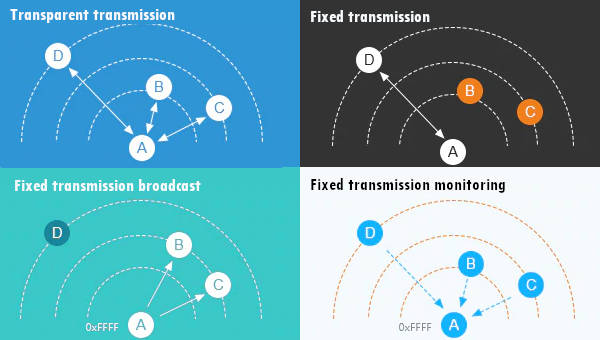
But It isn’t a standard scenario, and we usually want to send to a specified point and receive a response.
If you have trouble with the device’s freeze, you must put a pull-up 4.7k resistor or better connect to the device AUX pin.
Normal mode
For normal transmission, you must set M0 and M1 to LOW, and It’s better if you connect the AUX pin to have a better synchronization, but not needed. You can check the connection of the AUX pin in the library complete example connection, and you only must add the PIN to the constructor.
| M0 | GND (Set normal mode) |
| M1 | GND (Set normal mode) |
| TX | PIN 2 (PullUP 4,7KΩ) |
| RX | PIN 3 (PullUP 4,7KΩ & Voltage divider) |
| AUX | Not connected (PullUP 4,7KΩ) |
| VCC | 5v |
| GND | GND |
and this configuration for Wemos D1 mini:
| M0 | GND (Set normal mode) |
| M1 | GND (Set normal mode) |
| TX | PIN D2 (PullUP 4,7KΩ) |
| RX | PIN D3 (PullUP 4,7KΩ) |
| AUX | Not connected (PullUP 4,7KΩ) |
| VCC | 3.3v/5v |
| GND | GND |
ESP-32:
| M0 | GND (Set normal mode) |
| M1 | GND (Set normal mode) |
| RX | TX2 (PullUP 4,7KΩ) |
| TX | RX2 (PullUP 4,7KΩ) |
| AUX | Not connected (PullUP 4,7KΩ) |
| VCC | 3.3v/5v |
| GND | GND |
Arduino MKR WiFi 1010:
| M0 | GND (Set normal mode) |
| M1 | GND (Set normal mode) |
| TX | PIN 14 Tx (PullUP 4,7KΩ) |
| RX | PIN 13 Rx (PullUP 4,7KΩ) |
| AUX | Not connected (PullUP 4,7KΩ) |
| VCC | 3.3v/5v |
| GND | GND |
So you must only instantiate the constructor.
// ---------- esp8266 pins --------------
//LoRa_E22 e22ttl(RX, TX, AUX, M0, M1); // Arduino RX <-- e22 TX, Arduino TX --> e22 RX
//LoRa_E22 e22ttl(D3, D4, D5, D7, D6); // Arduino RX <-- e22 TX, Arduino TX --> e22 RX AUX M0 M1
//LoRa_E22 e22ttl(D2, D3); // Config without connect AUX and M0 M1
//#include <SoftwareSerial.h>
//SoftwareSerial mySerial(D2, D3); // Arduino RX <-- e22 TX, Arduino TX --> e22 RX
//LoRa_E22 e22ttl(&mySerial, D5, D7, D6); // AUX M0 M1
// -------------------------------------
// ---------- Arduino pins --------------
LoRa_E22 e22ttl(4, 5, 3, 7, 6); // Arduino RX <-- e22 TX, Arduino TX --> e22 RX AUX M0 M1
//LoRa_E22 e22ttl(4, 5); // Config without connect AUX and M0 M1
//#include <SoftwareSerial.h>
//SoftwareSerial mySerial(4, 5); // Arduino RX <-- e22 TX, Arduino TX --> e22 RX
//LoRa_E22 e22ttl(&mySerial, 3, 7, 6); // AUX M0 M1
// -------------------------------------
// ------------- Arduino Nano 33 IoT -------------
// LoRa_E22 e22ttl(&Serial1, 2, 4, 6); // RX AUX M0 M1
// -------------------------------------------------
// ------------- Arduino MKR WiFi 1010 -------------
// LoRa_E22 e22ttl(&Serial1, 2, 4, 6); // RX AUX M0 M1
// -------------------------------------------------
// ---------- esp32 pins --------------
//LoRa_E22 e22ttl(&Serial2, 18, 21, 19); // RX AUX M0 M1
//LoRa_E22 e22ttl(&Serial2, 22, 4, 18, 21, 19, UART_BPS_RATE_9600); // esp32 RX <-- e22 TX, esp32 TX --> e22 RX AUX M0 M1
// -------------------------------------
Transparent transmission
Generic sketch, select the correct constructor for every device:
/*
* LoRa E22
* send a transparent message, you must check that the transmitter and receiver have the same
* CHANNEL ADDL and ADDH
*
* Renzo Mischianti <https://mischianti.org>
* https://mischianti.org/category/my-libraries/ebyte-lora-e22-devices/
*
* E22 ----- Arduino
* M0 ----- 7 (or GND)
* M1 ----- 6 (or GND)
* RX ----- 4 (PullUP)
* TX ----- 5 (PullUP)
* AUX ----- 3 (PullUP)
* VCC ----- 3.3v/5v
* GND ----- GND
*
*/
#include "Arduino.h"
#include "LoRa_E22.h"
// ---------- esp8266 pins --------------
//LoRa_E22 e22ttl(RX, TX, AUX, M0, M1); // Arduino RX <-- e22 TX, Arduino TX --> e22 RX
//LoRa_E22 e22ttl(D3, D4, D5, D7, D6); // Arduino RX <-- e22 TX, Arduino TX --> e22 RX AUX M0 M1
//LoRa_E22 e22ttl(D2, D3); // Config without connect AUX and M0 M1
//#include <SoftwareSerial.h>
//SoftwareSerial mySerial(D2, D3); // Arduino RX <-- e22 TX, Arduino TX --> e22 RX
//LoRa_E22 e22ttl(&mySerial, D5, D7, D6); // AUX M0 M1
// -------------------------------------
// ---------- Arduino pins --------------
LoRa_E22 e22ttl(4, 5, 3, 7, 6); // Arduino RX <-- e22 TX, Arduino TX --> e22 RX AUX M0 M1
//LoRa_E22 e22ttl(4, 5); // Config without connect AUX and M0 M1
//#include <SoftwareSerial.h>
//SoftwareSerial mySerial(4, 5); // Arduino RX <-- e22 TX, Arduino TX --> e22 RX
//LoRa_E22 e22ttl(&mySerial, 3, 7, 6); // AUX M0 M1
// -------------------------------------
// ---------- esp32 pins --------------
// LoRa_E22 e22ttl(&Serial2, 18, 21, 19); // RX AUX M0 M1
//LoRa_E22 e22ttl(&Serial2, 22, 4, 18, 21, 19, UART_BPS_RATE_9600); // esp32 RX <-- e22 TX, esp32 TX --> e22 RX AUX M0 M1
// -------------------------------------
void setup() {
Serial.begin(9600);
delay(500);
// Startup all pins and UART
e22ttl.begin();
// If you have ever change configuration you must restore It
// ResponseStructContainer c;
// c = e22ttl.getConfiguration();
// Configuration configuration = *(Configuration*) c.data;
// Serial.println(c.status.getResponseDescription());
// configuration.CHAN = 0x17;
// configuration.OPTION.fixedTransmission = FT_TRANSPARENT_TRANSMISSION;
// e22ttl.setConfiguration(configuration, WRITE_CFG_PWR_DWN_SAVE);
Serial.println("Hi, I'm going to send message!");
// Send message
ResponseStatus rs = e22ttl.sendMessage("Hello, world?");
// Check If there is some problem of succesfully send
Serial.println(rs.getResponseDescription());
}
void loop() {
// If something available
if (e22ttl.available()>1) {
// read the String message
ResponseContainer rc = e22ttl.receiveMessage();
// Is something goes wrong print error
if (rc.status.code!=1){
Serial.println(rc.status.getResponseDescription());
}else{
// Print the data received
Serial.println(rc.status.getResponseDescription());
Serial.println(rc.data);
}
}
if (Serial.available()) {
String input = Serial.readString();
e22ttl.sendMessage(input);
}
}
If you have already changed the configuration, you must restore the default parameters:
// If you have ever change configuration you must restore It
ResponseStructContainer c;
c = e22ttl.getConfiguration();
Configuration configuration = *(Configuration*) c.data;
Serial.println(c.status.getResponseDescription());
configuration.ADDL = 0x03;
configuration.ADDH = 0x00;
configuration.NETID = 0x00;
configuration.CHAN = 23;
configuration.SPED.uartBaudRate = UART_BPS_9600;
configuration.SPED.airDataRate = AIR_DATA_RATE_010_24;
configuration.SPED.uartParity = MODE_00_8N1;
configuration.OPTION.subPacketSetting = SPS_240_00;
configuration.OPTION.RSSIAmbientNoise = RSSI_AMBIENT_NOISE_DISABLED;
configuration.OPTION.transmissionPower = POWER_22;
configuration.TRANSMISSION_MODE.enableRSSI = RSSI_DISABLED;
configuration.TRANSMISSION_MODE.fixedTransmission = FT_TRANSPARENT_TRANSMISSION;
configuration.TRANSMISSION_MODE.enableRepeater = REPEATER_DISABLED;
configuration.TRANSMISSION_MODE.enableLBT = LBT_DISABLED;
configuration.TRANSMISSION_MODE.WORTransceiverControl = WOR_RECEIVER;
configuration.TRANSMISSION_MODE.WORPeriod = WOR_2000_011;
e22ttl.setConfiguration(configuration, WRITE_CFG_PWR_DWN_SAVE);
c.close();
Transparent transmission and RSSI
In telecommunications, a received signal strength indicator (RSSI) measures the power present in a received radio signal.
RSSI is usually invisible to a user of a receiving device. However, because signal strength can vary greatly and affect functionality in wireless networking, IEEE 802.11 devices often make the measurement available to users.
This device supports RSSI, and in some situations, It’s very useful. To use It, you must activate the configuration flag.
// If you have ever change configuration you must restore It
ResponseStructContainer c;
c = e22ttl.getConfiguration();
Configuration configuration = *(Configuration*) c.data;
Serial.println(c.status.getResponseDescription());
configuration.ADDL = 0x03;
configuration.ADDH = 0x00;
configuration.NETID = 0x00;
configuration.CHAN = 23;
configuration.SPED.uartBaudRate = UART_BPS_9600;
configuration.SPED.airDataRate = AIR_DATA_RATE_010_24;
configuration.SPED.uartParity = MODE_00_8N1;
configuration.OPTION.subPacketSetting = SPS_240_00;
configuration.OPTION.RSSIAmbientNoise = RSSI_AMBIENT_NOISE_DISABLED;
configuration.OPTION.transmissionPower = POWER_22;
configuration.TRANSMISSION_MODE.enableRSSI = RSSI_ENABLED;
configuration.TRANSMISSION_MODE.fixedTransmission = FT_TRANSPARENT_TRANSMISSION;
configuration.TRANSMISSION_MODE.enableRepeater = REPEATER_DISABLED;
configuration.TRANSMISSION_MODE.enableLBT = LBT_DISABLED;
configuration.TRANSMISSION_MODE.WORTransceiverControl = WOR_RECEIVER;
configuration.TRANSMISSION_MODE.WORPeriod = WOR_2000_011;
e22ttl.setConfiguration(configuration, WRITE_CFG_PWR_DWN_SAVE);
c.close();
After configuration, we can go to use the method created to manage the RSSI value: receiveMessageRSSI().
For the transmitter, all the process was managed by configuration; only the receiver must use a “special” method to retrieve the value. So the previous sketch becomes like so:
/*
* LoRa E22
* send a transparent message, you must check that the transmitter and receiver have the same
* CHANNEL ADDL and ADDH
*
* Pai attention e22 support RSSI, if you want use that functionality you must enable RSSI on configuration
* configuration.TRANSMISSION_MODE.enableRSSI = RSSI_ENABLED;
*
* Renzo Mischianti <https://mischianti.org>
* https://mischianti.org/category/my-libraries/ebyte-lora-e22-devices/
*
*/
#include "Arduino.h"
#include "LoRa_E22.h"
// ---------- esp8266 pins --------------
//LoRa_E22 e22ttl(RX, TX, AUX, M0, M1); // Arduino RX <-- e22 TX, Arduino TX --> e22 RX
// LoRa_E22 e22ttl(D3, D4, D5, D7, D6); // Arduino RX <-- e22 TX, Arduino TX --> e22 RX AUX M0 M1
//LoRa_E22 e22ttl(D2, D3); // Config without connect AUX and M0 M1
//#include <SoftwareSerial.h>
//SoftwareSerial mySerial(D2, D3); // Arduino RX <-- e22 TX, Arduino TX --> e22 RX
//LoRa_E22 e22ttl(&mySerial, D5, D7, D6); // AUX M0 M1
// -------------------------------------
// ---------- Arduino pins --------------
LoRa_E22 e22ttl(4, 5, 3, 7, 6); // Arduino RX <-- e22 TX, Arduino TX --> e22 RX AUX M0 M1
//LoRa_E22 e22ttl(4, 5); // Config without connect AUX and M0 M1
//#include <SoftwareSerial.h>
//SoftwareSerial mySerial(4, 5); // Arduino RX <-- e22 TX, Arduino TX --> e22 RX
//LoRa_E22 e22ttl(&mySerial, 3, 7, 6); // AUX M0 M1
// -------------------------------------
// ------------- Arduino Nano 33 IoT -------------
// LoRa_E22 e22ttl(&Serial1, 2, 4, 6); // RX AUX M0 M1
// -------------------------------------------------
// ------------- Arduino MKR WiFi 1010 -------------
// LoRa_E22 e22ttl(&Serial1, 2, 4, 6); // RX AUX M0 M1
// -------------------------------------------------
// ---------- esp32 pins --------------
//LoRa_E22 e22ttl(&Serial2, 18, 21, 19); // RX AUX M0 M1
//LoRa_E22 e22ttl(&Serial2, 22, 4, 18, 21, 19, UART_BPS_RATE_9600); // esp32 RX <-- e22 TX, esp32 TX --> e22 RX AUX M0 M1
// -------------------------------------
void setup() {
Serial.begin(9600);
delay(500);
// Startup all pins and UART
e22ttl.begin();
Serial.println("Hi, I'm going to send message!");
// Send message
ResponseStatus rs = e22ttl.sendMessage("Hello, world?");
// Check If there is some problem of succesfully send
Serial.println(rs.getResponseDescription());
}
void loop() {
// If something available
if (e22ttl.available()>1) {
// read the String message
ResponseContainer rc = e22ttl.receiveMessageRSSI();
// Is something goes wrong print error
if (rc.status.code!=1){
Serial.println(rc.status.getResponseDescription());
}else{
// Print the data received
Serial.println(rc.status.getResponseDescription());
Serial.println(rc.data);
Serial.print("RSSI: "); Serial.println(rc.rssi, DEC);
}
}
if (Serial.available()) {
String input = Serial.readString();
e22ttl.sendMessage(input);
}
}
Fixed transmission
For fixed transmission, you must set M0 and M1 to LOW, and It’s better to connect the AUX pin to have a better synchronization.
Fixed transmission: point to point
To use this type of transmission, we must set a parameter on configuration and set a specified address for every device.
So first, we must set M0 to LOW and M1 pin to HIGH to enter on program/sleep mode and set the correct address and fixed transmission flag.
If we want to replicate the condition of the sender in the upper image, we must do this configuration.
ResponseStructContainer c;
c = e22ttl.getConfiguration();
Configuration configuration = *(Configuration*) c.data;
configuration.ADDL = 0x02;
configuration.ADDH = 0x00;
configuration.NETID = 0x00;
configuration.CHAN = 23;
configuration.SPED.uartBaudRate = UART_BPS_9600;
configuration.SPED.airDataRate = AIR_DATA_RATE_010_24;
configuration.SPED.uartParity = MODE_00_8N1;
configuration.OPTION.subPacketSetting = SPS_240_00;
configuration.OPTION.RSSIAmbientNoise = RSSI_AMBIENT_NOISE_DISABLED;
configuration.OPTION.transmissionPower = POWER_22;
configuration.TRANSMISSION_MODE.enableRSSI = RSSI_DISABLED;
configuration.TRANSMISSION_MODE.fixedTransmission = FT_FIXED_TRANSMISSION;
configuration.TRANSMISSION_MODE.enableRepeater = REPEATER_DISABLED;
configuration.TRANSMISSION_MODE.enableLBT = LBT_DISABLED;
configuration.TRANSMISSION_MODE.WORTransceiverControl = WOR_TRANSMITTER;
configuration.TRANSMISSION_MODE.WORPeriod = WOR_2000_011;
e22ttl.setConfiguration(configuration, WRITE_CFG_PWR_DWN_SAVE);
c.close();
Then for the receiver device, we must set this configuration.
ResponseStructContainer c;
c = e22ttl.getConfiguration();
Configuration configuration = *(Configuration*) c.data;
configuration.ADDL = 0x03;
configuration.ADDH = 0x00;
configuration.NETID = 0x00;
configuration.CHAN = 23;
configuration.SPED.uartBaudRate = UART_BPS_9600;
configuration.SPED.airDataRate = AIR_DATA_RATE_010_24;
configuration.SPED.uartParity = MODE_00_8N1;
configuration.OPTION.subPacketSetting = SPS_240_00;
configuration.OPTION.RSSIAmbientNoise = RSSI_AMBIENT_NOISE_DISABLED;
configuration.OPTION.transmissionPower = POWER_22;
configuration.TRANSMISSION_MODE.enableRSSI = RSSI_DISABLED;
configuration.TRANSMISSION_MODE.fixedTransmission = FT_FIXED_TRANSMISSION;
configuration.TRANSMISSION_MODE.enableRepeater = REPEATER_DISABLED;
configuration.TRANSMISSION_MODE.enableLBT = LBT_DISABLED;
configuration.TRANSMISSION_MODE.WORTransceiverControl = WOR_RECEIVER;
configuration.TRANSMISSION_MODE.WORPeriod = WOR_2000_011;
e22ttl.setConfiguration(configuration, WRITE_CFG_PWR_DWN_SAVE);
c.close();
Now we can send a message to the specified device.
#define DESTINATION_ADDL 2
// Send message
ResponseStatus rs = e22ttl.sendFixedMessage(0, DESTINATION_ADDL, 23, "Hello, world?");
// Check If there is some problem of succesfully send
Serial.println(rs.getResponseDescription());
The receiver is like the transparent one because the device manages the address and channel.
void loop()
{
// If something available
if (e22ttl.available()>1) {
// read the String message
ResponseContainer rc = e22ttl.receiveMessage();
// Is something goes wrong print error
if (rc.status.code!=1){
Serial.println(rc.status.getResponseDescription());
}else{
// Print the data received
Serial.println(rc.status.getResponseDescription());
Serial.println(rc.data);
}
}
}
Pay attention to these lines of code:
// With FIXED SENDER configuration
// #define DESTINATION_ADDL 3
// With FIXED RECEIVER configuration
#define DESTINATION_ADDL 2
You must uncomment the correct DESTINATION_ADDL for the sender and the receiver.
Sender and receive sketch:
/*
* EBYTE LoRa E22
* Send a string message to a fixed point ADDH ADDL CHAN 0 2 23
*
* Write a string on serial monitor or reset to resend default value.
*
* Send a fixed point message, you must check that the transmitter and receiver have different
* CHANNEL ADDL or ADDH, check down the correct configuration
*
* Renzo Mischianti <https://mischianti.org>
* https://mischianti.org/category/my-libraries/ebyte-lora-e22-devices/
*
*/
// With FIXED SENDER configuration
// #define DESTINATION_ADDL 3
// With FIXED RECEIVER configuration
#define DESTINATION_ADDL 2
#include "Arduino.h"
#include "LoRa_E22.h"
// ---------- esp8266 pins --------------
//LoRa_E22 e22ttl(RX, TX, AUX, M0, M1); // Arduino RX <-- e22 TX, Arduino TX --> e22 RX
// LoRa_E22 e22ttl(D3, D4, D5, D7, D6); // Arduino RX <-- e22 TX, Arduino TX --> e22 RX AUX M0 M1
//LoRa_E22 e22ttl(D2, D3); // Config without connect AUX and M0 M1
//#include <SoftwareSerial.h>
//SoftwareSerial mySerial(D2, D3); // Arduino RX <-- e22 TX, Arduino TX --> e22 RX
//LoRa_E22 e22ttl(&mySerial, D5, D7, D6); // AUX M0 M1
// -------------------------------------
// ---------- Arduino pins --------------
LoRa_E22 e22ttl(4, 5, 3, 7, 6); // Arduino RX <-- e22 TX, Arduino TX --> e22 RX AUX M0 M1
//LoRa_E22 e22ttl(4, 5); // Config without connect AUX and M0 M1
//#include <SoftwareSerial.h>
//SoftwareSerial mySerial(4, 5); // Arduino RX <-- e22 TX, Arduino TX --> e22 RX
//LoRa_E22 e22ttl(&mySerial, 3, 7, 6); // AUX M0 M1
// -------------------------------------
// ------------- Arduino Nano 33 IoT -------------
// LoRa_E22 e22ttl(&Serial1, 2, 4, 6); // RX AUX M0 M1
// -------------------------------------------------
// ------------- Arduino MKR WiFi 1010 -------------
// LoRa_E22 e22ttl(&Serial1, 2, 4, 6); // RX AUX M0 M1
// -------------------------------------------------
// ---------- esp32 pins --------------
//LoRa_E22 e22ttl(&Serial2, 18, 21, 19); // RX AUX M0 M1
//LoRa_E22 e22ttl(&Serial2, 22, 4, 18, 21, 19, UART_BPS_RATE_9600); // esp32 RX <-- e22 TX, esp32 TX --> e22 RX AUX M0 M1
// -------------------------------------
void printParameters(struct Configuration configuration);
void setup() {
Serial.begin(9600);
delay(500);
// Startup all pins and UART
e22ttl.begin();
ResponseStructContainer c;
c = e22ttl.getConfiguration();
// It's important get configuration pointer before all other operation
Configuration configuration = *(Configuration*) c.data;
Serial.println(c.status.getResponseDescription());
Serial.println(c.status.code);
printParameters(configuration);
c.close();
Serial.println("Hi, I'm going to send message!");
// Send message
ResponseStatus rs = e22ttl.sendFixedMessage(0, DESTINATION_ADDL, 23, "Hello, world?");
// Check If there is some problem of succesfully send
Serial.println(rs.getResponseDescription());
}
void loop() {
// If something available
if (e22ttl.available()>1) {
// read the String message
ResponseContainer rc = e22ttl.receiveMessage();
// Is something goes wrong print error
if (rc.status.code!=1){
Serial.println(rc.status.getResponseDescription());
}else{
// Print the data received
Serial.println(rc.status.getResponseDescription());
Serial.println(rc.data);
}
}
if (Serial.available()) {
String input = Serial.readString();
e22ttl.sendFixedMessage(0, DESTINATION_ADDL, 23, input);
}
}
void printParameters(struct Configuration configuration) {
Serial.println("----------------------------------------");
Serial.print(F("HEAD : ")); Serial.print(configuration.COMMAND, HEX);Serial.print(" ");Serial.print(configuration.STARTING_ADDRESS, HEX);Serial.print(" ");Serial.println(configuration.LENGHT, HEX);
Serial.println(F(" "));
Serial.print(F("AddH : ")); Serial.println(configuration.ADDH, HEX);
Serial.print(F("AddL : ")); Serial.println(configuration.ADDL, HEX);
Serial.print(F("NetID : ")); Serial.println(configuration.NETID, HEX);
Serial.println(F(" "));
Serial.print(F("Chan : ")); Serial.print(configuration.CHAN, DEC); Serial.print(" -> "); Serial.println(configuration.getChannelDescription());
Serial.println(F(" "));
Serial.print(F("SpeedParityBit : ")); Serial.print(configuration.SPED.uartParity, BIN);Serial.print(" -> "); Serial.println(configuration.SPED.getUARTParityDescription());
Serial.print(F("SpeedUARTDatte : ")); Serial.print(configuration.SPED.uartBaudRate, BIN);Serial.print(" -> "); Serial.println(configuration.SPED.getUARTBaudRateDescription());
Serial.print(F("SpeedAirDataRate : ")); Serial.print(configuration.SPED.airDataRate, BIN);Serial.print(" -> "); Serial.println(configuration.SPED.getAirDataRateDescription());
Serial.println(F(" "));
Serial.print(F("OptionSubPacketSett: ")); Serial.print(configuration.OPTION.subPacketSetting, BIN);Serial.print(" -> "); Serial.println(configuration.OPTION.getSubPacketSetting());
Serial.print(F("OptionTranPower : ")); Serial.print(configuration.OPTION.transmissionPower, BIN);Serial.print(" -> "); Serial.println(configuration.OPTION.getTransmissionPowerDescription());
Serial.print(F("OptionRSSIAmbientNo: ")); Serial.print(configuration.OPTION.RSSIAmbientNoise, BIN);Serial.print(" -> "); Serial.println(configuration.OPTION.getRSSIAmbientNoiseEnable());
Serial.println(F(" "));
Serial.print(F("TransModeWORPeriod : ")); Serial.print(configuration.TRANSMISSION_MODE.WORPeriod, BIN);Serial.print(" -> "); Serial.println(configuration.TRANSMISSION_MODE.getWORPeriodByParamsDescription());
Serial.print(F("TransModeTransContr: ")); Serial.print(configuration.TRANSMISSION_MODE.WORTransceiverControl, BIN);Serial.print(" -> "); Serial.println(configuration.TRANSMISSION_MODE.getWORTransceiverControlDescription());
Serial.print(F("TransModeEnableLBT : ")); Serial.print(configuration.TRANSMISSION_MODE.enableLBT, BIN);Serial.print(" -> "); Serial.println(configuration.TRANSMISSION_MODE.getLBTEnableByteDescription());
Serial.print(F("TransModeEnableRSSI: ")); Serial.print(configuration.TRANSMISSION_MODE.enableRSSI, BIN);Serial.print(" -> "); Serial.println(configuration.TRANSMISSION_MODE.getRSSIEnableByteDescription());
Serial.print(F("TransModeEnabRepeat: ")); Serial.print(configuration.TRANSMISSION_MODE.enableRepeater, BIN);Serial.print(" -> "); Serial.println(configuration.TRANSMISSION_MODE.getRepeaterModeEnableByteDescription());
Serial.print(F("TransModeFixedTrans: ")); Serial.print(configuration.TRANSMISSION_MODE.fixedTransmission, BIN);Serial.print(" -> "); Serial.println(configuration.TRANSMISSION_MODE.getFixedTransmissionDescription());
Serial.println("----------------------------------------");
}
Fixed transmission with RSSI:
To manage RSSI, It’s must be enabled via configuration, so the configuration for the sender becomes like this:
ResponseStructContainer c;
c = e22ttl.getConfiguration();
Configuration configuration = *(Configuration*) c.data;
configuration.ADDL = 0x02;
configuration.ADDH = 0x00;
configuration.NETID = 0x00;
configuration.CHAN = 23;
configuration.SPED.uartBaudRate = UART_BPS_9600;
configuration.SPED.airDataRate = AIR_DATA_RATE_010_24;
configuration.SPED.uartParity = MODE_00_8N1;
configuration.OPTION.subPacketSetting = SPS_240_00;
configuration.OPTION.RSSIAmbientNoise = RSSI_AMBIENT_NOISE_DISABLED;
configuration.OPTION.transmissionPower = POWER_22;
configuration.TRANSMISSION_MODE.enableRSSI = RSSI_ENABLED;
configuration.TRANSMISSION_MODE.fixedTransmission = FT_FIXED_TRANSMISSION;
configuration.TRANSMISSION_MODE.enableRepeater = REPEATER_DISABLED;
configuration.TRANSMISSION_MODE.enableLBT = LBT_DISABLED;
configuration.TRANSMISSION_MODE.WORTransceiverControl = WOR_TRANSMITTER;
configuration.TRANSMISSION_MODE.WORPeriod = WOR_2000_011;
e22ttl.setConfiguration(configuration, WRITE_CFG_PWR_DWN_SAVE);
c.close();
and for the receiver:
ResponseStructContainer c;
c = e22ttl.getConfiguration();
Configuration configuration = *(Configuration*) c.data;
configuration.ADDL = 0x03;
configuration.ADDH = 0x00;
configuration.NETID = 0x00;
configuration.CHAN = 23;
configuration.SPED.uartBaudRate = UART_BPS_9600;
configuration.SPED.airDataRate = AIR_DATA_RATE_010_24;
configuration.SPED.uartParity = MODE_00_8N1;
configuration.OPTION.subPacketSetting = SPS_240_00;
configuration.OPTION.RSSIAmbientNoise = RSSI_AMBIENT_NOISE_DISABLED;
configuration.OPTION.transmissionPower = POWER_22;
configuration.TRANSMISSION_MODE.enableRSSI = RSSI_ENABLED;
configuration.TRANSMISSION_MODE.fixedTransmission = FT_FIXED_TRANSMISSION;
configuration.TRANSMISSION_MODE.enableRepeater = REPEATER_DISABLED;
configuration.TRANSMISSION_MODE.enableLBT = LBT_DISABLED;
configuration.TRANSMISSION_MODE.WORTransceiverControl = WOR_RECEIVER;
configuration.TRANSMISSION_MODE.WORPeriod = WOR_2000_011;
e22ttl.setConfiguration(configuration, WRITE_CFG_PWR_DWN_SAVE);
c.close();
Also, in this sketch, pay attention to these lines of code:
// With FIXED SENDER configuration
// #define DESTINATION_ADDL 3
// With FIXED RECEIVER configuration
#define DESTINATION_ADDL 2
You must uncomment the correct DESTINATION_ADDL for the sender and the receiver.
And here is the sketch with RSSI:
/*
* EBYTE LoRa E22
* Send a string message to a fixed point ADDH ADDL CHAN 0 2 23
*
* Write a string on serial monitor or reset to resend default value.
*
* Send a fixed point message, you must check that the transmitter and receiver have different
* CHANNEL ADDL or ADDH, check down the correct configuration
*
* Pai attention e22 support RSSI, if you want use that functionality you must enable RSSI on configuration
* configuration.TRANSMISSION_MODE.enableRSSI = RSSI_ENABLED;
*
* Renzo Mischianti <https://mischianti.org>
* https://mischianti.org/category/my-libraries/ebyte-lora-e22-devices/
*
*/
// With FIXED SENDER configuration
// #define DESTINATION_ADDL 3
// With FIXED RECEIVER configuration
#define DESTINATION_ADDL 2
#include "Arduino.h"
#include "LoRa_E22.h"
// ---------- esp8266 pins --------------
//LoRa_E22 e22ttl(RX, TX, AUX, M0, M1); // Arduino RX <-- e22 TX, Arduino TX --> e22 RX
// LoRa_E22 e22ttl(D3, D4, D5, D7, D6); // Arduino RX <-- e22 TX, Arduino TX --> e22 RX AUX M0 M1
//LoRa_E22 e22ttl(D2, D3); // Config without connect AUX and M0 M1
//#include <SoftwareSerial.h>
//SoftwareSerial mySerial(D2, D3); // Arduino RX <-- e22 TX, Arduino TX --> e22 RX
//LoRa_E22 e22ttl(&mySerial, D5, D7, D6); // AUX M0 M1
// -------------------------------------
// ---------- Arduino pins --------------
LoRa_E22 e22ttl(4, 5, 3, 7, 6); // Arduino RX <-- e22 TX, Arduino TX --> e22 RX AUX M0 M1
//LoRa_E22 e22ttl(4, 5); // Config without connect AUX and M0 M1
//#include <SoftwareSerial.h>
//SoftwareSerial mySerial(4, 5); // Arduino RX <-- e22 TX, Arduino TX --> e22 RX
//LoRa_E22 e22ttl(&mySerial, 3, 7, 6); // AUX M0 M1
// -------------------------------------
// ------------- Arduino Nano 33 IoT -------------
// LoRa_E22 e22ttl(&Serial1, 2, 4, 6); // RX AUX M0 M1
// -------------------------------------------------
// ------------- Arduino MKR WiFi 1010 -------------
// LoRa_E22 e22ttl(&Serial1, 2, 4, 6); // RX AUX M0 M1
// -------------------------------------------------
// ---------- esp32 pins --------------
//LoRa_E22 e22ttl(&Serial2, 18, 21, 19); // RX AUX M0 M1
//LoRa_E22 e22ttl(&Serial2, 22, 4, 18, 21, 19, UART_BPS_RATE_9600); // esp32 RX <-- e22 TX, esp32 TX --> e22 RX AUX M0 M1
// -------------------------------------
void printParameters(struct Configuration configuration);
void setup() {
Serial.begin(9600);
delay(500);
// Startup all pins and UART
e22ttl.begin();
ResponseStructContainer c;
c = e22ttl.getConfiguration();
// It's important get configuration pointer before all other operation
Configuration configuration = *(Configuration*) c.data;
Serial.println(c.status.getResponseDescription());
Serial.println(c.status.code);
printParameters(configuration);
c.close();
Serial.println("Hi, I'm going to send message!");
// Send message
ResponseStatus rs = e22ttl.sendFixedMessage(0, DESTINATION_ADDL, 23, "Hello, world?");
// Check If there is some problem of succesfully send
Serial.println(rs.getResponseDescription());
}
void loop() {
// If something available
if (e22ttl.available()>1) {
// read the String message
ResponseContainer rc = e22ttl.receiveMessageRSSI();
// Is something goes wrong print error
if (rc.status.code!=1){
Serial.println(rc.status.getResponseDescription());
}else{
// Print the data received
Serial.println(rc.status.getResponseDescription());
Serial.println(rc.data);
Serial.print("RSSI: "); Serial.println(rc.rssi, DEC);
}
}
if (Serial.available()) {
String input = Serial.readString();
e22ttl.sendFixedMessage(0, DESTINATION_ADDL, 23, input);
}
}
void printParameters(struct Configuration configuration) {
Serial.println("----------------------------------------");
Serial.print(F("HEAD : ")); Serial.print(configuration.COMMAND, HEX);Serial.print(" ");Serial.print(configuration.STARTING_ADDRESS, HEX);Serial.print(" ");Serial.println(configuration.LENGHT, HEX);
Serial.println(F(" "));
Serial.print(F("AddH : ")); Serial.println(configuration.ADDH, HEX);
Serial.print(F("AddL : ")); Serial.println(configuration.ADDL, HEX);
Serial.print(F("NetID : ")); Serial.println(configuration.NETID, HEX);
Serial.println(F(" "));
Serial.print(F("Chan : ")); Serial.print(configuration.CHAN, DEC); Serial.print(" -> "); Serial.println(configuration.getChannelDescription());
Serial.println(F(" "));
Serial.print(F("SpeedParityBit : ")); Serial.print(configuration.SPED.uartParity, BIN);Serial.print(" -> "); Serial.println(configuration.SPED.getUARTParityDescription());
Serial.print(F("SpeedUARTDatte : ")); Serial.print(configuration.SPED.uartBaudRate, BIN);Serial.print(" -> "); Serial.println(configuration.SPED.getUARTBaudRateDescription());
Serial.print(F("SpeedAirDataRate : ")); Serial.print(configuration.SPED.airDataRate, BIN);Serial.print(" -> "); Serial.println(configuration.SPED.getAirDataRateDescription());
Serial.println(F(" "));
Serial.print(F("OptionSubPacketSett: ")); Serial.print(configuration.OPTION.subPacketSetting, BIN);Serial.print(" -> "); Serial.println(configuration.OPTION.getSubPacketSetting());
Serial.print(F("OptionTranPower : ")); Serial.print(configuration.OPTION.transmissionPower, BIN);Serial.print(" -> "); Serial.println(configuration.OPTION.getTransmissionPowerDescription());
Serial.print(F("OptionRSSIAmbientNo: ")); Serial.print(configuration.OPTION.RSSIAmbientNoise, BIN);Serial.print(" -> "); Serial.println(configuration.OPTION.getRSSIAmbientNoiseEnable());
Serial.println(F(" "));
Serial.print(F("TransModeWORPeriod : ")); Serial.print(configuration.TRANSMISSION_MODE.WORPeriod, BIN);Serial.print(" -> "); Serial.println(configuration.TRANSMISSION_MODE.getWORPeriodByParamsDescription());
Serial.print(F("TransModeTransContr: ")); Serial.print(configuration.TRANSMISSION_MODE.WORTransceiverControl, BIN);Serial.print(" -> "); Serial.println(configuration.TRANSMISSION_MODE.getWORTransceiverControlDescription());
Serial.print(F("TransModeEnableLBT : ")); Serial.print(configuration.TRANSMISSION_MODE.enableLBT, BIN);Serial.print(" -> "); Serial.println(configuration.TRANSMISSION_MODE.getLBTEnableByteDescription());
Serial.print(F("TransModeEnableRSSI: ")); Serial.print(configuration.TRANSMISSION_MODE.enableRSSI, BIN);Serial.print(" -> "); Serial.println(configuration.TRANSMISSION_MODE.getRSSIEnableByteDescription());
Serial.print(F("TransModeEnabRepeat: ")); Serial.print(configuration.TRANSMISSION_MODE.enableRepeater, BIN);Serial.print(" -> "); Serial.println(configuration.TRANSMISSION_MODE.getRepeaterModeEnableByteDescription());
Serial.print(F("TransModeFixedTrans: ")); Serial.print(configuration.TRANSMISSION_MODE.fixedTransmission, BIN);Serial.print(" -> "); Serial.println(configuration.TRANSMISSION_MODE.getFixedTransmissionDescription());
Serial.println("----------------------------------------");
}
Fixed transmission: broadcast
We can test the broadcast communication with the exact configuration of the address and channel.
To do a test, you can create three devices with these three configurations:
Device 1:
configuration.ADDL = 0x04;
configuration.ADDH = 0x00;
configuration.NETID = 0x00;
configuration.CHAN = 23;
configuration.SPED.uartBaudRate = UART_BPS_9600;
configuration.SPED.airDataRate = AIR_DATA_RATE_010_24;
configuration.SPED.uartParity = MODE_00_8N1;
configuration.OPTION.subPacketSetting = SPS_240_00;
configuration.OPTION.RSSIAmbientNoise = RSSI_AMBIENT_NOISE_DISABLED;
configuration.OPTION.transmissionPower = POWER_22;
configuration.TRANSMISSION_MODE.enableRSSI = RSSI_DISABLED;
configuration.TRANSMISSION_MODE.fixedTransmission = FT_FIXED_TRANSMISSION;
configuration.TRANSMISSION_MODE.enableRepeater = REPEATER_DISABLED;
configuration.TRANSMISSION_MODE.enableLBT = LBT_DISABLED;
configuration.TRANSMISSION_MODE.WORTransceiverControl = WOR_RECEIVER;
configuration.TRANSMISSION_MODE.WORPeriod = WOR_2000_011;
Device 2:
configuration.ADDL = 0x05;
configuration.ADDH = 0x00;
configuration.NETID = 0x00;
configuration.CHAN = 23;
configuration.SPED.uartBaudRate = UART_BPS_9600;
configuration.SPED.airDataRate = AIR_DATA_RATE_010_24;
configuration.SPED.uartParity = MODE_00_8N1;
configuration.OPTION.subPacketSetting = SPS_240_00;
configuration.OPTION.RSSIAmbientNoise = RSSI_AMBIENT_NOISE_DISABLED;
configuration.OPTION.transmissionPower = POWER_22;
configuration.TRANSMISSION_MODE.enableRSSI = RSSI_DISABLED;
configuration.TRANSMISSION_MODE.fixedTransmission = FT_FIXED_TRANSMISSION;
configuration.TRANSMISSION_MODE.enableRepeater = REPEATER_DISABLED;
configuration.TRANSMISSION_MODE.enableLBT = LBT_DISABLED;
configuration.TRANSMISSION_MODE.WORTransceiverControl = WOR_RECEIVER;
configuration.TRANSMISSION_MODE.WORPeriod = WOR_2000_011;
Device 3:
configuration.ADDL = 0x06;
configuration.ADDH = 0x00;
configuration.NETID = 0x00;
configuration.CHAN = 23;
configuration.SPED.uartBaudRate = UART_BPS_9600;
configuration.SPED.airDataRate = AIR_DATA_RATE_010_24;
configuration.SPED.uartParity = MODE_00_8N1;
configuration.OPTION.subPacketSetting = SPS_240_00;
configuration.OPTION.RSSIAmbientNoise = RSSI_AMBIENT_NOISE_DISABLED;
configuration.OPTION.transmissionPower = POWER_22;
configuration.TRANSMISSION_MODE.enableRSSI = RSSI_DISABLED;
configuration.TRANSMISSION_MODE.fixedTransmission = FT_FIXED_TRANSMISSION;
configuration.TRANSMISSION_MODE.enableRepeater = REPEATER_DISABLED;
configuration.TRANSMISSION_MODE.enableLBT = LBT_DISABLED;
configuration.TRANSMISSION_MODE.WORTransceiverControl = WOR_RECEIVER;
configuration.TRANSMISSION_MODE.WORPeriod = WOR_2000_011;
// Send message
ResponseStatus rs = e22ttl.sendBroadcastFixedMessage(23, "Hello, world?");
// Check If there is some problem of succesfully send
Serial.println(rs.getResponseDescription());
Or
// Send message
ResponseStatus rs = e22ttl.sendFixedMessage(BROADCAST_ADDRESS, BROADCAST_ADDRESS, 4, "Send message to channel 4");
Serial.println(rs.getResponseDescription());
The receiver, as described, has the same code because the device manages the preamble with Address and Channel.
Here is the sender sketch:
/*
* EBYTE LoRa E22
*
* Send a string message to the all devices of channel 23
*
* Write a string on serial monitor or reset to resend default value.
*
* Send a fixed message, you must check that the transmitter and receiver have different
* CHANNEL ADDL or ADDH, check the configuration down
*
* Pai attention e22 support RSSI, if you want use that functionality you must enable RSSI on configuration
* configuration.TRANSMISSION_MODE.enableRSSI = RSSI_ENABLED;
*
* and uncomment #define ENABLE_RSSI true in this sketch
*
* You must select 3 devices, and you must use the configuration
* BROADCAST MESSAGE 1
* BROADCAST MESSAGE 2
* BROADCAST MESSAGE 3
*
* Renzo Mischianti <https://mischianti.org>
* https://mischianti.org/category/my-libraries/ebyte-lora-e22-devices/
*
* E22 ----- Arduino
* M0 ----- 7 (or GND)
* M1 ----- 6 (or GND)
* RX ----- 4 (PullUP)
* TX ----- 5 (PullUP)
* AUX ----- 3 (PullUP)
* VCC ----- 3.3v/5v
* GND ----- GND
*
*/
// If you want use RSSI uncomment //#define ENABLE_RSSI true
// and use relative configuration with RSSI enabled
//#define ENABLE_RSSI true
#include "Arduino.h"
#include "LoRa_E22.h"
// ---------- esp8266 pins --------------
//LoRa_E22 e22ttl(RX, TX, AUX, M0, M1); // Arduino RX <-- e22 TX, Arduino TX --> e22 RX
// LoRa_E22 e22ttl(D3, D4, D5, D7, D6); // Arduino RX <-- e22 TX, Arduino TX --> e22 RX AUX M0 M1
//LoRa_E22 e22ttl(D2, D3); // Config without connect AUX and M0 M1
//#include <SoftwareSerial.h>
//SoftwareSerial mySerial(D2, D3); // Arduino RX <-- e22 TX, Arduino TX --> e22 RX
//LoRa_E22 e22ttl(&mySerial, D5, D7, D6); // AUX M0 M1
// -------------------------------------
// ---------- Arduino pins --------------
LoRa_E22 e22ttl(4, 5, 3, 7, 6); // Arduino RX <-- e22 TX, Arduino TX --> e22 RX AUX M0 M1
//LoRa_E22 e22ttl(4, 5); // Config without connect AUX and M0 M1
//#include <SoftwareSerial.h>
//SoftwareSerial mySerial(4, 5); // Arduino RX <-- e22 TX, Arduino TX --> e22 RX
//LoRa_E22 e22ttl(&mySerial, 3, 7, 6); // AUX M0 M1
// -------------------------------------
// ------------- Arduino Nano 33 IoT -------------
// LoRa_E22 e22ttl(&Serial1, 2, 4, 6); // RX AUX M0 M1
// -------------------------------------------------
// ------------- Arduino MKR WiFi 1010 -------------
// LoRa_E22 e22ttl(&Serial1, 2, 4, 6); // RX AUX M0 M1
// -------------------------------------------------
// ---------- esp32 pins --------------
//LoRa_E22 e22ttl(&Serial2, 18, 21, 19); // RX AUX M0 M1
//LoRa_E22 e22ttl(&Serial2, 22, 4, 18, 21, 19, UART_BPS_RATE_9600); // esp32 RX <-- e22 TX, esp32 TX --> e22 RX AUX M0 M1
// -------------------------------------
void setup() {
Serial.begin(9600);
delay(500);
// Startup all pins and UART
e22ttl.begin();
Serial.println("Hi, I'm going to send message!");
// Send message
ResponseStatus rs = e22ttl.sendBroadcastFixedMessage(23, "Hello, world?");
// Check If there is some problem of succesfully send
Serial.println(rs.getResponseDescription());
}
void loop() {
// If something available
if (e22ttl.available()>1) {
// read the String message
#ifdef ENABLE_RSSI
ResponseContainer rc = e22ttl.receiveMessageRSSI();
#else
ResponseContainer rc = e22ttl.receiveMessage();
#endif
// Is something goes wrong print error
if (rc.status.code!=1){
Serial.println(rc.status.getResponseDescription());
}else{
// Print the data received
Serial.println(rc.status.getResponseDescription());
Serial.println(rc.data);
#ifdef ENABLE_RSSI
Serial.print("RSSI: "); Serial.println(rc.rssi, DEC);
#endif
}
}
if (Serial.available()) {
String input = Serial.readString();
ResponseStatus rs = e22ttl.sendBroadcastFixedMessage(23, input);
// Check If there is some problem of succesfully send
Serial.println(rs.getResponseDescription());
}
}
Fixed transmission: monitoring
As you have already seen on the first schema, you can hear all messages in the specified channel, and you must configure your address like so, with an address equal to 0xFFFF.
configuration.ADDL = BROADCAST_ADDRESS;
configuration.ADDH = BROADCAST_ADDRESS;
configuration.NETID = 0x00;
configuration.CHAN = 23;
configuration.SPED.uartBaudRate = UART_BPS_9600;
configuration.SPED.airDataRate = AIR_DATA_RATE_010_24;
configuration.SPED.uartParity = MODE_00_8N1;
configuration.OPTION.subPacketSetting = SPS_240_00;
configuration.OPTION.RSSIAmbientNoise = RSSI_AMBIENT_NOISE_DISABLED;
configuration.OPTION.transmissionPower = POWER_22;
configuration.TRANSMISSION_MODE.enableRSSI = RSSI_DISABLED;
configuration.TRANSMISSION_MODE.fixedTransmission = FT_FIXED_TRANSMISSION;
configuration.TRANSMISSION_MODE.enableRepeater = REPEATER_DISABLED;
configuration.TRANSMISSION_MODE.enableLBT = LBT_DISABLED;
configuration.TRANSMISSION_MODE.WORTransceiverControl = WOR_RECEIVER;
configuration.TRANSMISSION_MODE.WORPeriod = WOR_2000_011;
To receive the messages:
/*
* EBYTE LoRa E22
*
* Write a string on serial monitor or reset to resend default value.
*
* Send a fixed message, you must check that the transmitter and receiver have different
* CHANNEL ADDL or ADDH, check the configuration down
*
* Pai attention e22 support RSSI, if you want use that functionality you must enable RSSI on configuration
* configuration.TRANSMISSION_MODE.enableRSSI = RSSI_ENABLED;
*
* and uncomment #define ENABLE_RSSI true in this sketch
*
* Renzo Mischianti <https://mischianti.org>
* https://mischianti.org/category/my-libraries/ebyte-lora-e22-devices/
*
* E22 ----- Arduino
* M0 ----- 7 (or GND)
* M1 ----- 6 (or GND)
* RX ----- 4 (PullUP)
* TX ----- 5 (PullUP)
* AUX ----- 3 (PullUP)
* VCC ----- 3.3v/5v
* GND ----- GND
*
*/
#define DESTINATION_ADDL 3
// If you want use RSSI uncomment //#define ENABLE_RSSI true
// and use relative configuration with RSSI enabled
//#define ENABLE_RSSI true
#include "Arduino.h"
#include "LoRa_E22.h"
// ---------- esp8266 pins --------------
//LoRa_E22 e22ttl(RX, TX, AUX, M0, M1); // Arduino RX <-- e22 TX, Arduino TX --> e22 RX
// LoRa_E22 e22ttl(D3, D4, D5, D7, D6); // Arduino RX <-- e22 TX, Arduino TX --> e22 RX AUX M0 M1
//LoRa_E22 e22ttl(D2, D3); // Config without connect AUX and M0 M1
//#include <SoftwareSerial.h>
//SoftwareSerial mySerial(D2, D3); // Arduino RX <-- e22 TX, Arduino TX --> e22 RX
//LoRa_E22 e22ttl(&mySerial, D5, D7, D6); // AUX M0 M1
// -------------------------------------
// ---------- Arduino pins --------------
LoRa_E22 e22ttl(4, 5, 3, 7, 6); // Arduino RX <-- e22 TX, Arduino TX --> e22 RX AUX M0 M1
//LoRa_E22 e22ttl(4, 5); // Config without connect AUX and M0 M1
//#include <SoftwareSerial.h>
//SoftwareSerial mySerial(4, 5); // Arduino RX <-- e22 TX, Arduino TX --> e22 RX
//LoRa_E22 e22ttl(&mySerial, 3, 7, 6); // AUX M0 M1
// -------------------------------------
// ------------- Arduino Nano 33 IoT -------------
// LoRa_E22 e22ttl(&Serial1, 2, 4, 6); // RX AUX M0 M1
// -------------------------------------------------
// ------------- Arduino MKR WiFi 1010 -------------
// LoRa_E22 e22ttl(&Serial1, 2, 4, 6); // RX AUX M0 M1
// -------------------------------------------------
// ---------- esp32 pins --------------
//LoRa_E22 e22ttl(&Serial2, 18, 21, 19); // RX AUX M0 M1
//LoRa_E22 e22ttl(&Serial2, 22, 4, 18, 21, 19, UART_BPS_RATE_9600); // esp32 RX <-- e22 TX, esp32 TX --> e22 RX AUX M0 M1
// -------------------------------------
void setup() {
Serial.begin(9600);
delay(500);
// Startup all pins and UART
e22ttl.begin();
// Serial.println("Hi, I'm going to send message!");
//
// // Send message
// ResponseStatus rs = e22ttl.sendFixedMessage(0, DESTINATION_ADDL, 23, "Hello, world?");
// // Check If there is some problem of succesfully send
// Serial.println(rs.getResponseDescription());
}
void loop() {
// If something available
if (e22ttl.available()>1) {
// read the String message
#ifdef ENABLE_RSSI
ResponseContainer rc = e22ttl.receiveMessageRSSI();
#else
ResponseContainer rc = e22ttl.receiveMessage();
#endif
// Is something goes wrong print error
if (rc.status.code!=1){
Serial.println(rc.status.getResponseDescription());
}else{
// Print the data received
Serial.println(rc.status.getResponseDescription());
Serial.println(rc.data);
#ifdef ENABLE_RSSI
Serial.print("RSSI: "); Serial.println(rc.rssi, DEC);
#endif
}
}
if (Serial.available()) {
String input = Serial.readString();
e22ttl.sendFixedMessage(0, DESTINATION_ADDL, 23, input);
}
}
Thanks
- Ebyte LoRa E22 device for Arduino, esp32 or esp8266: settings and basic usage
- Ebyte LoRa E22 device for Arduino, esp32 or esp8266: library
- Ebyte LoRa E22 device for Arduino, esp32 or esp8266: configuration
- Ebyte LoRa E22 device for Arduino, esp32 or esp8266: fixed transmission, broadcast, monitor, and RSSI
- Ebyte LoRa E22 device for Arduino, esp32 or esp8266: power-saving and sending structured data
- Ebyte LoRa E22 device for Arduino, esp32 or esp8266: repeater mode and remote settings
- Ebyte LoRa E22 device for Arduino, esp32 or esp8266: WOR microcontroller and Arduino shield
- Ebyte LoRa E22 device for Arduino, esp32 or esp8266: WOR microcontroller and WeMos D1 shield
- Ebyte LoRa E22 device for Arduino, esp32 or esp8266: WOR microcontroller and esp32 dev v1 shield
Shield and PCB

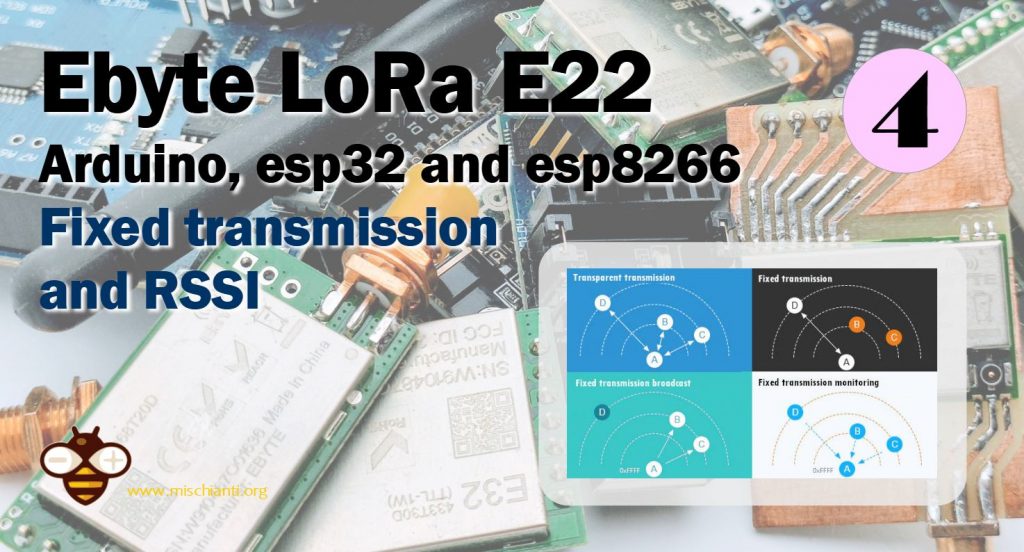

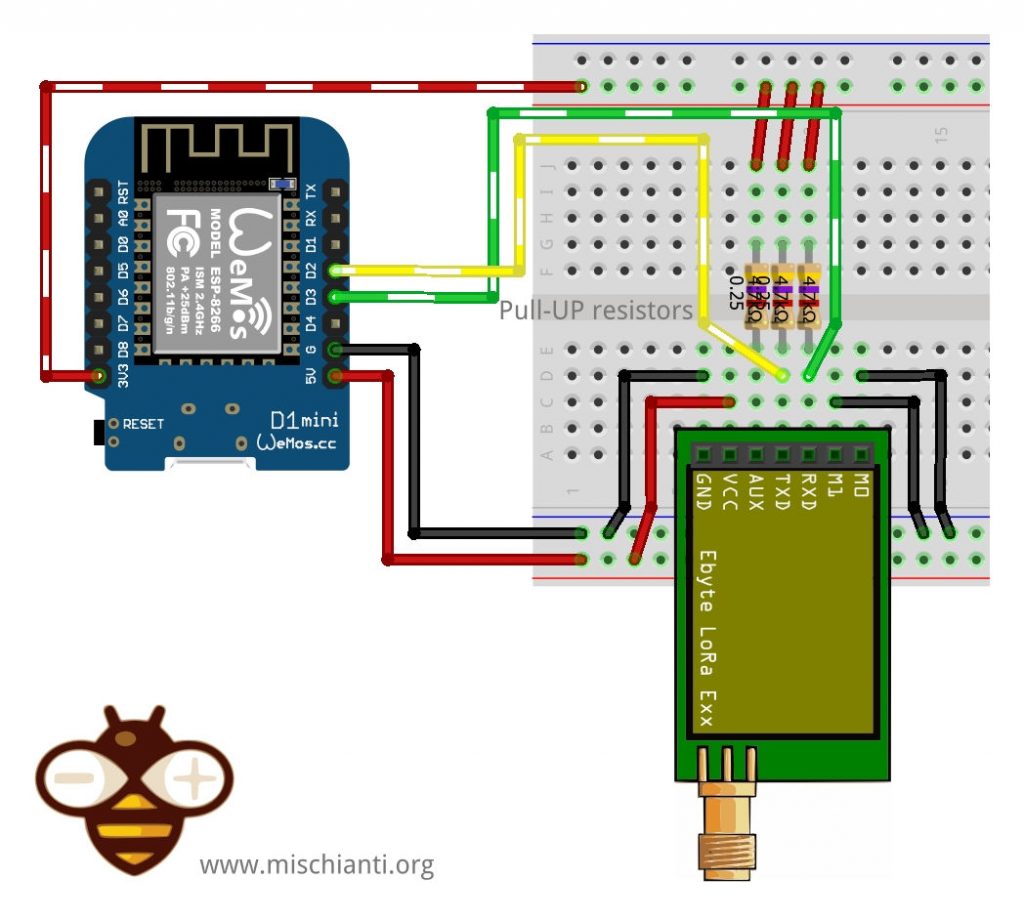
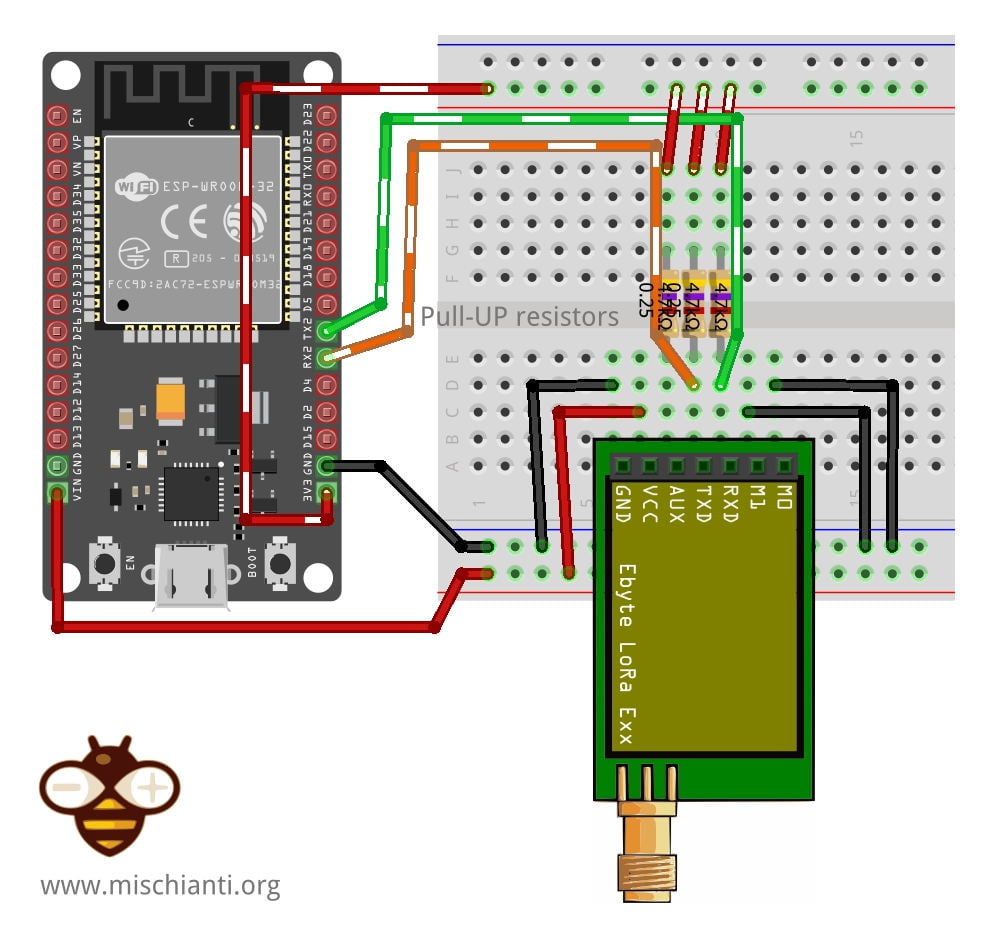

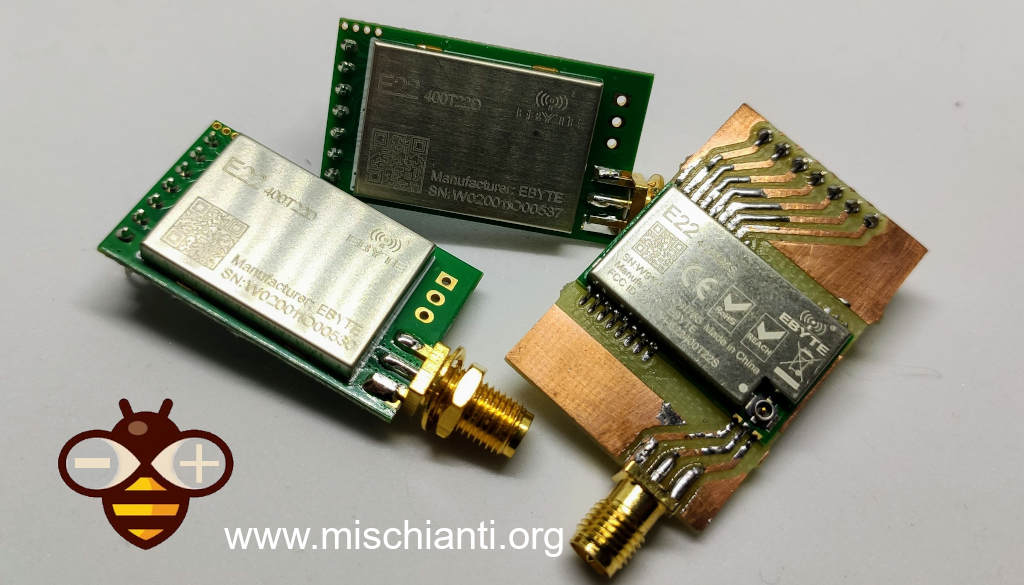
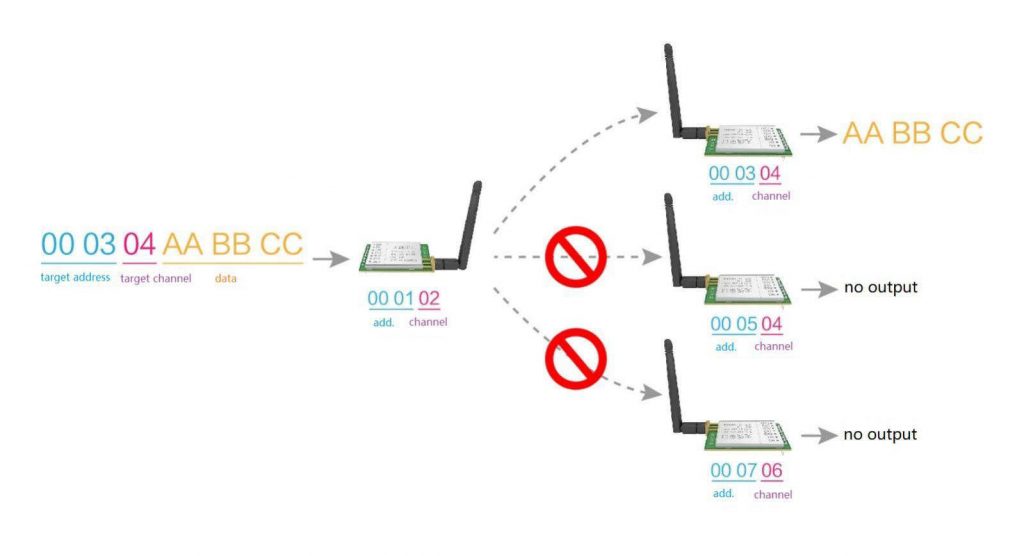
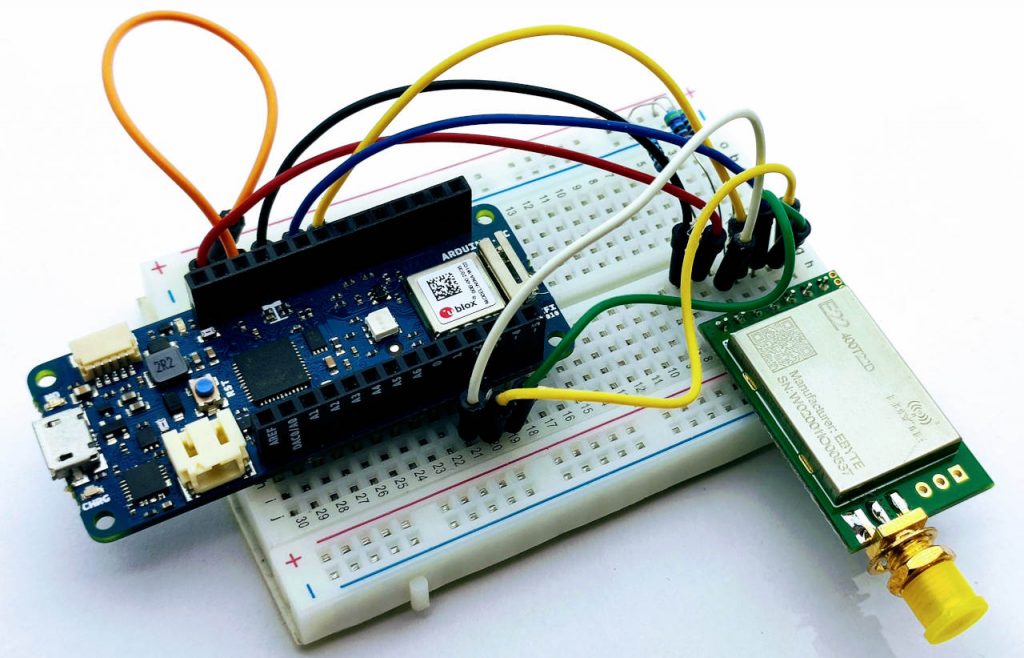
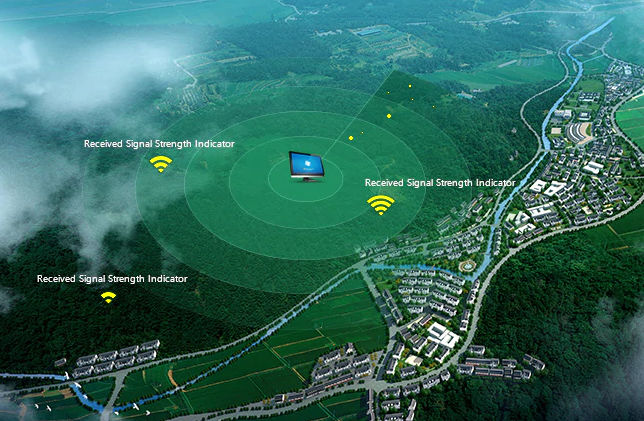
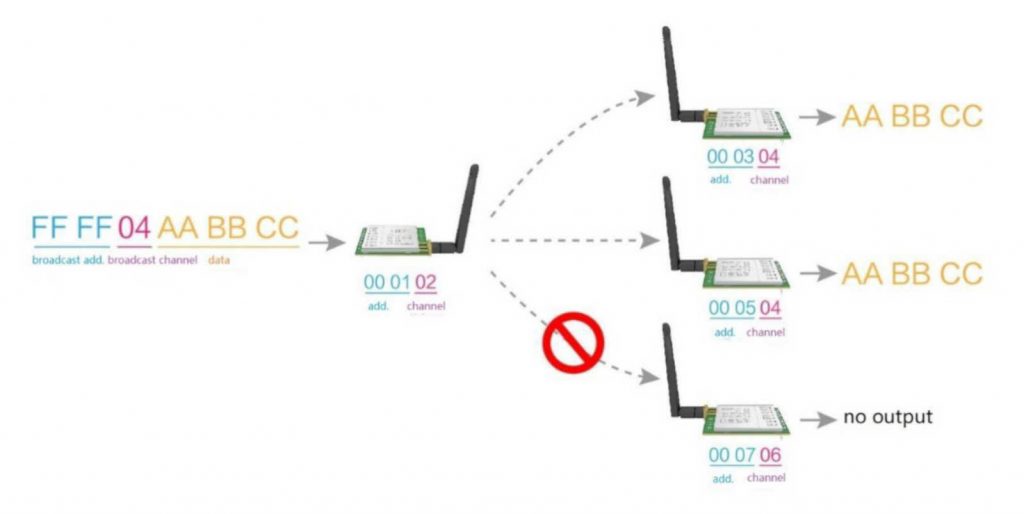











Hi,
based on the illustrations we can see easily that “transparent transmission” is a clear communication that any Lora can intercept but what about the “fixed transmission” are the communication encrypted?
Thanks
Hi Souriza,
the difference from the transparent and fixed transmission is that:
– messages in transparent are sent to all the devices with the config set to transparent and the same CHANNEL;
– messages in fixed are sent to a specified CHANNEL ADDL ADDH.
All the messages are encrypted.
Bye Renzo
hi renzo,
i took your code and try to get the RSSI output. In the configuration I have, as described by you here configuration.TRANSMISSION_MODE.enableRSSI = RSSI_ENABLED enabeld, however I get as output regardless of antenna, distance only 48 as value back. do you have an idea what this is?
Used devices are an Arduino Uno and Ebyte E22 module, connected with RX/TX as described by your.
Hi Daniel,
if the device is too close sometime It doesn’t work, and remember to set RSSI_ENABLED on the receiver also.
Bye Renzo
Hi Renzo,
I’m testing a similar ebyte module in the Fixed Transmission scenario. With a single message it seems fine, the data is received. When I send several messages in succession however, the address and channel bytes are also included in the received data!
How does ebyte know when the address and channel bytes are intended to be used for addressing, and when they are actual data?
Hi Ross,
I think that the problem is that the device permit the continuous transmission and if you send the message without interval It consider the second message the prosecution of the first.
Some people remove my limit of packet size and send biggest data in multiple stream.
I must add a method to send data without preamble to use for that situation.
Even if your situation It’s very strange, can you open a forum topic and paste the code?
Thanks Renzo
Hi Renzo,
I’m testing a similar ebyte module E22 in the Fixed Transmission scenario at a very close range.When I tried to send a 32 byte packet at 62.5k and found that only about 15 packets were sent out in 1s, I think it’s too little. And the receiver seems to receive slowly when I send fast, either packet loss, or the serial port does not output anything, what is the situation? Or is this the limit of the module?Did you test how many packets you can send out the fastest?
Hi T,
you connect the AUX pin?
Bye RM
Hi,Renzo,I connect the AUX pin.
You must try to change the Serial baudrate also, It’s essential to retrieve the messages from the buffer before It become full.
I never tested the speed or other performance settings, but disabling FEC and a good antenna can also speed up the transfer.
Bye Renzo
thanks, the transmission rate I tested is very slow, far from 62.5k , a packet of 12 bytes from one end to the other end and then through the serial port display, needs about 0.17s.I just simply used “e22ttl.sendFixedMessage” and “e22ttl.receiveMessage()”,this is so weird.
Hi Renzo,
First of all I thank you for your contribution to the LoRa world.
My question is;
I have established communication line between two Lora E22 nodes (Transmitter having arduino nano, RX#1 nodemcu esp8266 and RX#2 arduino nano as an MCU).
I send a message from tx unit (sent message is “Soil Dry, Humidity: 1022”) to two receiving nodes. Arduino+LoraE22 node is receiving whole message exactly same , but Nodemcu+LoraE22 node is receiving message different in numeric part (Soil Dry, Humidity: 1886344195). NODEMCU+E22 node codes are adapted from ARDUINO+E22 node codes because pinouts are different.
What could be the problem?
Thank you in advance.
Hi Rasiber,
It’s very strange, try to open a forum topic and post your code, we are going to check if there are some problems.
Bye Renzo
Hello! Thank you again for your great website about the EBYTE E22. I have a question – Can you confirm that NETID is used ONLY in repeater mode? I think I am confusing this with CHANNELID which is frequency.
Hi Richard,
yes, you are right the NETID is used only for repeater mode as you can see in the schema.
And yes, CHAN is the channel of the device that is a specified value plus the CHAN value.
Bye Renzo
Thank you for your quick and clear response!
I just wanted to add that even if you are not in repeater mode, you still have to have the NETID set the same for both the transmitter and receiver. If I do not do this then the transmission does not go through
Hello yet again! Is there any easy way to separate received messages? If I have multiple messages coming in, sometimes my E22 reports them individually, but sometimes it combines them. The length of my messages will change so I cannot assume any specific size. In the python library for the receive_messages() function I see:
def receive_message(self, rssi=False, delimiter=None, size=None):
Since I don’t know what size to expect, does this mean I need to broadcast some fixed value as a delimiter? Is there some other way to separate multiple messages in the E22’s buffer?
Hi Richard,
I assume that you use a String message format, for that I add a function with the delimiter as you suggest, As you know you must select an end character and add in every send transmission.
Bye Renzo
Thank you for your response. This makes sense to me given that the E22 is basically just a wireless serial connection device. Too bad it cannot split up messages into individual buffers like the nRF24L01. I was hoping to NOT use a delimiter because that costs one extra byte of payload… Maybe I’m being too cheap! Thank you for your guidance!
Actually I do have a question for you: I am transmitting binary data, not string. In this case I don’t think a delimiter would work because the delimiter value may appear somewhere in the payload as well as at the end. I also cannot use a fixed message size since the payload may change depending on the source. Can you suggest any strategy to use to separate messages without a delimiter or fixed payload size??
Hi Richard,
you can find a specified example here.
My solution is to read the head of the message and then use the correct structure to read the rest of the structure.
Bye Renzo
Hello again – I see what you are saying; basically we have to a “head” on the message to identify its structure. Very clever. Thank you for your advice!
It’s a basic solution, but It’s work well for me.
Bye Renzo